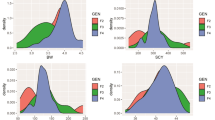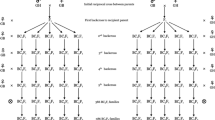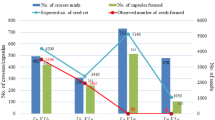Abstract
BALLS (“The Cotton Plant in Egypt”, 1912) made the discovery that in the cotton plant, self pollen was somewhat prepotent over foreign pollen, in interspecific crosses between Egyptian cotton (Gossypium barbadense L.) and Upland cotton (G. hirsutum L.). Thus if stigmas of barbadense were pollinated with a mixture of barbadense and hirsutum pollen, most of the ovules were fertilized with barbadense. The reverse was found with hirsutum. The prepotency of self pollen over foreign pollen was rediscovered by Jones some years later in maize, and other plants are now known to follow this rule.
This is a preview of subscription content, access via your institution
Access options
Subscribe to this journal
Receive 51 print issues and online access
$199.00 per year
only $3.90 per issue
Buy this article
- Purchase on SpringerLink
- Instant access to full article PDF
Prices may be subject to local taxes which are calculated during checkout
Similar content being viewed by others
Author information
Authors and Affiliations
Rights and permissions
About this article
Cite this article
HARLAND, S. Breeding of a Cotton Immune from Natural Crossing. Nature 151, 307 (1943). https://doi.org/10.1038/151307a0
Issue date:
DOI: https://doi.org/10.1038/151307a0
This article is cited by
-
Gene flow between cultivated and wild sunflowers
Theoretical and Applied Genetics (1994)
-
Mode of reproduction of higher plants
The Botanical Review (1957)
-
Hybrid vigor in cotton—Cytogenelic aspects and practical applications
Economic Botany (1951)
-
Contamination of seed crops
Journal of Genetics (1947)
-
GENETICAL ASPECTS OF SEED-GROWING*
Nature (1946)



